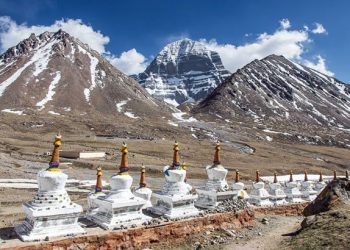Mount Kailash is the most sacred mountain in Tibet. Kailash trek follows the pilgrim’s ancient footsteps around the mountain where a three-day Kailash Kora trek is reputed to forgive a lifetime of sin. Mount Kailash trek that leads around the sacred Mount Kailash in western Tibet following the pilgrims’ route. Though short, this high-altitude trek is not to be undertaken lightly – Mount Kailash remains isolated and remote, and getting there is an epic journey in itself.
Isolated for centuries behind the Himalayas in Tibet is a mysterious and mythical mountain, Mount Kailash standing 6714m high. The mountain has for more than a thousand years been a central pilgrimage site for some of the world’s major religions. Mount Kailash Trekking is one of the most demanding and challenging of treks for pilgrims in the world. This trek route in Tibet is widely known as the kora around the Mt. Kailash(6638m) which is sacred to four religions and a deeply numinous place. The average altitude of this trekking is nearly 5,000m, so it is a very great challenge and requires strong perseverance.
Traditionally, Mt.Kailash Trek is done in 3 day trek around holy Mt Kailash together with a visit to sacred Manasrovar Lake in western Tibet. To many Indian tourists, a holy bath in the Manasrovaris also an integral part of the journey. If you prefer to visit Mt. Kailash from China, Tibet Permit is needed to enter Tibet along with China visa, and if you decided to visit Mount Kailash from Kathmandu, then in addition to Tibet travel permit, you need to have China/Tibet group paper Visa to enter Tibet. You need to have at least 3 days in Kathmandu to process group Visa with your original passport.
April to mid-October is the best time for Kailash trekking. Traveling in April, May, June, Sept and first half of Oct. You will enjoy the incredible clear blue sky, crisp air and high visibility, with temperature staying at around 8 to 9 degree on average. July and August is monsoon season rain half of the rainfall in the whole year. Drolma La Pass (5630m), the highest point for Mt Kailash Trek, the unexpected snowfall and severe weather can happen at any given time in the whole year. If you come in April, you are likely to walk on rugged mountains trail, covered with snow and ice. So, walk slowly and mind your steps.
After mid-Oct, the freezing cold weather prompts locals to temporarily close their guesthouses or tented campstill next April, which marks the end of Mt.Kailash trek in a year. The most auspicious time to visit Mt.Kailash is in the Year of Horse and during Saga Dawa Festival around the 15th day of April in the Tibetan calendar. Local Tibetans are deeply convinced that going one circle around Mt.Kailash in the year of Horse, the blessings you get would be 13 times more than usual and the wish you made will be more likely to come true. While Saga Dawa falls on that day which is also the birthday of Buddha Sakyamuni. During this festival, Tibetans from all over Tibet pour into this area of Mt. Kailash. The giant flagpole at Tarpoche is ritually taken down and the prayer flags along its length replaced. It is also a great time to do a Tibet tour, though it could be a bit crowded.
The inner kora of Mt Kailash Trek is not available for international tourists for safety concerns according to the travel policy. The inner kora trek covers 30km and can be done in a single day. However, you have to pass treacherous cliff and extremely high passes. Locals believe only after you have circled outer kora of Mt Kailash 13 times, you can be granted the chance to do inner kora of Mt.Kailash. So, the outerkora is the right way and only choice to go.
No matter with with the difficulty of Mt.Kailash trek. You have to prepare a good level of fitness. Swimming, hiking in mountains or hills, jogging, cycling and all these aerobic exercises will help you build up a better level of fitness and stamina for the arduous trek.
As the accommodation facilities have been greatly improved nowadays. There is no need to camp during the 3-day Kailash Trek. You can stay in the basic guest house at Dirapuk Monastery and Dzultripuk Monastery. And a few Tibetan-run tented camps down Dolma La Pass can be found offering basic food, such as instant noodle, soup and sweet tea, hot water and some stirred fried rice. A sleep bag is better if you can’t deal with the filthybed sheets. During your trek, most of the time, you can not find a private toilet, for ladies it can be an inconvenient small challenge. so do bring your toilet paper, wet tissue paper and toiletry.








